Ulster Bound
A trip to explore their Irish roots brings three generations closer to their Caledon home.
A faint, throaty “cuhh” marks each of my mother’s slumbering inhalations, like a slow, breathy metronome. “That’s amazing,” my son Mack says. He is looking on from the next seat in genuine, 11-year-old wonder, his gaze about 10 inches from my mom’s open mouth. Despite the cheek-by-jowl throng of chattering passengers settling in for the long flight to Dublin, his 85-year-old grandmother has fallen deeply, blissfully asleep in the five minutes since our early boarding of the plane.
“How are we going to do this,” sighs my husband Tim, bag in hand and peering into the already packed overhead bin. I, too, had been pondering this question, though not about our carry-on. If there is such a thing as shared genetic memory, the idea of three generations of my family travelling together to explore our Irish roots had just seemed important – at least that had been the thought after two drinks on a date night three months earlier.
And no sugar coating – transporting five people spanning three generations across the Atlantic and then squeezing everyone into a mid-sized Renault Mégane hatchback to drive 600 kilometres of remote Irish coastline is a big, messy ordeal. But as the metal tube hurled us ever farther from our Brimstone cottage, this faraway adventure was about to bring us inexorably closer to home.
The Return
I’m not a native of the Caledon Hills, just a resident of nearly 20 years. Still, in my bones, these hills have always felt like home. Now, I might know why. It turns out that Caledon village, Northern Ireland, is slightly more than 20 kilometres from the farm of my great-great-grandfather William Beatty senior. But when the border between Northern Ireland and the Republic of Ireland was drawn in the early 20th century, the former Beatty farm ended up on the Irish Republic side. It’s a region of luxuriant rolling hills, hardwood stands, streams and rivers brimming with trout. It’s a bucolic fly fisher’s haven, just beyond the Pale in medieval Irish terms, about an hour northwest of Dublin in Ulster.
The area known as Ulster comprises three counties now in the Republic of Ireland, as well as all the counties of Northern Ireland. Ulster is a region with no political standing, often riven by religion, but bound forever by deep roots in ancient Ireland. This is where our road trip begins – in a sense, back home.
At the family homestead, we find there isn’t much left in the way of buildings. The house is gone, but low stone fence lines still snake along rolling, impossibly green pastures, and there’s the ruin of an old dug well. Structures aside, little seems to have changed. Indeed, it is unnervingly easy to envision what William Beatty senior glimpsed for one last time in about 1835 as he set off with his young family for the Canadas. This was ten years before the potato famine devastated Ireland.
I watch as Mack and his older brother James help Mom select small cut stones from the well, treasures to take home with us. We hold these stones as if, as they warm in our hands, they will divulge the stories we’ve travelled so far to know. It’s hard to fully grasp what steeled our ancestors’ resolve to leave such beauty for so many unknowns. We’ll look for answers on the road ahead.
Ulster Scots
Surveying our now drizzle-soaked Michelin map – I prefer to navigate old school – I recognize the Irish roots of many Caledon communities back home: Tullamore, which straddles the former Chinguacousy, Albion and Toronto Gore Township lines; Kilmanagh in old Chinguacousy Township; and the Dingle, southeast of Mono Mills, among many others. Our Irish Ulster connection to Caledon, however, is a little more complicated, much like Ulster itself, and I don’t fit all the pieces together until we dig up details from some of the most reliable local sources.
“The best stuff I learn here comes from the pub,” Mack tells the Mullen’s Lounge barkeep between sips of ginger ale. An odd declaration from an 11-year-old, but utterly true. Sitting on the next stool, a regular of this Cootehill pub and funeral home directs Mack to two gravediggers in neighbouring Scotshouse for more intel on the local Beattys.
We find the two at their place of work, and with shovels in hand they point us to Dermot Beatty, who reportedly sips his first pint every day at about this time – 4:45 p.m. – just yards down the street at Connolly’s Wines and Spirits. And as predicted, that’s where we find him.
“You must be Dermot.” His ruddy 40-something face blanches somewhat as a five-foot octogenarian sidles up to his stool at the otherwise empty bar. Emboldened by our mission, Mom soon has Dermot corroborating our research. He confirms that our people arrived in this area in about 1609 via the Scottish Protestant “plantation,” the beginning of a raw chapter in Ireland’s conflicted Protestant-Catholic, Anglo-Irish history. Dermot adds that precisely 101 Beattys were “planted” here in County Cavan. Others of our horse-thieving clan along the Scottish borders were killed off by King James I of England.
I take odd comfort in the knowledge our ancestors were decidedly of the underclass at a time when many native Irish chieftains lost control of their land to Protestant aristocrats loyal to the British throne. True to human nature, some of the new landlords were benevolent to their leaseholders and some were not. Eventually, both rich and poor Scottish transplants became known as Ulster Scots.
Now, the connection to Caledon, Ontario, becomes clear. The name “Caledon” – a shortened version of “Caledonia,” the Latin name for Scotland – always seemed an obvious nod to the area’s Scottish pioneers. But the headstones of many early settlers in the Caledon village cemetery on Highway 10 suggest another possibility.
There’s Edward Clark, an immigrant from County Monaghan, who was laid to rest in 1847 at age 116. David Laughlin was from County Tyrone. There’s a McNeil from County Antrim, and a Dodd from County Monaghan. There are Potters, Nisbets, Adams, Lindsays, Maxwells, Wigginses, Crookshanks, Stubbses, Raeburns and others – all from Ulster, and as archival research confirms, many were Ulster Scots.
Of course, the much-loved Caledon politician, historian and volunteer Alex Raeburn, who recently died just after his 100th birthday, was the great-grandson of Ulster Scot pioneer Robert Raeburn from County Monaghan, very near Ulster’s Caledon village. Indeed, Ontario’s Caledon village was once known as Raeburn’s Corners. Perhaps Alex had his Ulster roots in mind when he championed the Town of Caledon’s official naming in 1974. One thing seems certain: Caledon’s presumed Scottish connection is in no small measure via Ulster, Ireland.
Sligo Junction
Heading west from Cavan, I begin to appreciate the love/hate thing the Irish have with their land. I’ve driven in Paris and Rome during rush hour, on sunbaked dirt roads in Provence and up the steep cobbled lanes of medieval Umbrian villages in a minivan with a stripped first gear. But nothing prepared me for the single-lane, hedge-rowed twining goat paths that are the road from Cavan to Sligo. Scenic or not, lorries and buses blow by at 100 km/h. Somehow our side mirrors survive. Ulster road crews would surely buckle in laughter at the 50-km/h speed limits on the Forks of the Credit Road back home.
Through it all, my mother sleeps, her default response to stress. Perhaps it’s the five hours in the car, but for some reason this surrender instinct is now pissing me off, as if somehow we should all be fretting and bracing. Then, just as I’m about to act on my bad mood, our labyrinth-like roadway opens to a broad, verdant plain with Sligo harbour and the vast blue Atlantic before us.
This is William Butler Yeats country. I think immediately of the repeated refrain of his poem “Easter, 1916.” “A terrible beauty is born,” Yeats wrote, conflicted about a bloody Irish uprising against British rule. Still, the phrase also fits the aching beauty of this northwestern countryside he loved so dearly. Imbued with the turmoil of British overlords, Scottish colonists, English persecution of Irish Catholics and Ulster Scot Presbyterians, and the famine, the Irish connection to their land is complicated, but never, ever indifferent.
As we motor north into Donegal, I try to imagine how you could forever leave behind a homeland like this. Then, looking up to the view ahead, I realize suddenly, you don’t.
I had only heard about Ben Bulben, the imposing tabletop mountain that for many defines the Sligo landscape. As Ben Bulben rises before me, I find its flat-topped silhouette strikingly familiar. Then I see it – the reason Inglewood, Ontario, was originally named Sligo Junction. I step into the shoes of the Hamilton & Northwestern Railway worker, an Irish immigrant who in 1877 saw the Niagara Escarpment’s similar silhouette and declared, “Sligo.”
Like Ben Bulben in Yeats country, the Escarpment defines our region. Its flat-topped profile, viewed from Highway 10 near the Grange Sideroad, always tells me I’m almost home. English settlers in the thriving H&NW railway village soon changed the name of Sligo Junction to the more Anglo Inglewood, and the name Sligo migrated north to the post office that once existed near the intersection of Forks of the Credit and McLaughlin Roads.
These myriad little connections linking the old to the new open my heart and eyes to the signposts created by the early immigrants to Caledon, and their yearning to make an unfamiliar landscape feel like home.
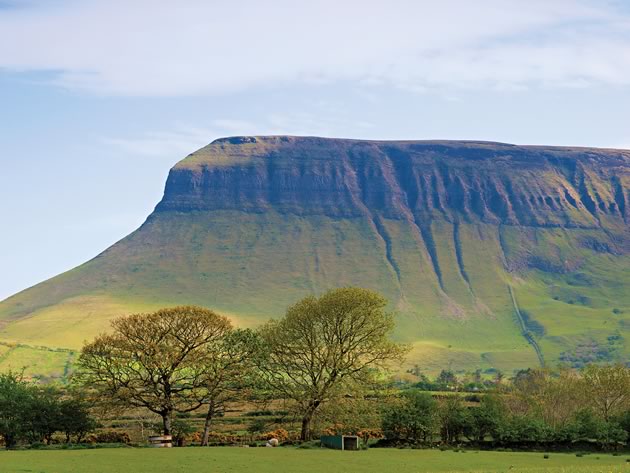
In Ireland, Ben Bulben defi nes the Sligo landscape. “I step into the shoes of the Hamilton & Northwestern Railway worker, an Irish immigrant who in 1877 saw the Niagara Escarpment’s similar silhouette and declared, ‘Sligo.’” Photo by Liz Beatty.
Wreck of the Empress
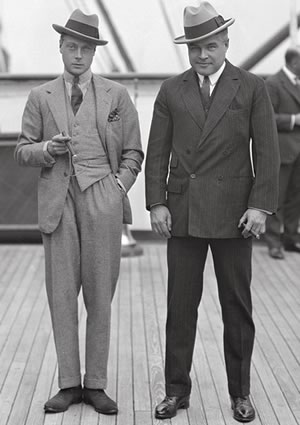
The Prince of Wales (left) and Edward W Beatty on the deck of the Empress of France, October 13, 1923. Canadian Pacific Archives NS11234.
Some “aha” travel moments sneak up on you. But you go looking for others, as we do near the northwestern coastal village of Dunfanaghy. In one stunning, no-granny-left-behind mission, James and his dad half carry Mom up a steep rocky trail to the highest lookout of Horn Head. Our perch here feels as if we’re at the edge of the universe, the Atlantic stretching beyond the horizon. On this spot it’s no stretch to imagine the tug of the New World on a young Irish heart.
Still, for us there’s even more to the dazzling view. A few miles offshore rests another family link: the wreck of the Empress of Britain II, a luxury liner turned Second World War troop transport, bombed by a German plane, then torpedoed and sunk by a German U-boat in 1940. In a recent truth-is-stranger-than-fiction revelation, we learned that Sir Edward Wentworth Beatty, great-great-grandfather’s great nephew, had commissioned the building of the Empress.
By the 1860s, Sir Edward’s father, nephew of the immigrant William Beatty senior, had joined the thriving shipping and timber business William and his sons had built from nothing after arriving in Upper Canada. Their success led to dealings with the Canadian Pacific Railway Company, and young Edward grew up around ships and railways.
By 1918, Sir Edward became the first Canadian-born president of the CPR, then one of the largest privately owned transportation networks in the world. He launched grand ocean liners, including the Empress of Britain II. He built the Royal York and rebuilt the Banff Springs Hotel into a Canadian icon, all to put Canada on a global stage. He spearheaded sweeping immigration strategies for Canada’s West. He was chancellor of McGill University. He directed the shipping of allied troops and goods in World War II. He started CP Air. He was befriended by kings and queens. But most remarkable to me, he had the opportunity to do all this because of the courage and industry of my great-great-grandfather, William, once an Ulster farmer born near Caledon village, Ireland.
Binnion Hill
As we travel north and east, dry stone walls climb the hills and cross the broad, treeless valleys of Donegal’s Inishowen Peninsula, at once stunning and desolate. Here and at home, I feel a primal connection to stone. Stone walls evoke for me a sense of permanence, hard work, accomplishment. When I was a kid, they were one of the things I loved most about the Caledon countryside – chunks of dolomite piled along property lines by pioneer farmers. Some show the best of Scottish and Irish dry-stone walling, like the restored Patullo wall on Mississauga Road at the Grange Sideroad, or the Coulterville wall at Charleston Sideroad and Main Street. What I see here near Clonmany, however, is a wall like none I’ve known.
“What’s with that?” I ask Tim as we sip morning coffee looking out the window of our B & B. Far across the valley a stone wall climbs 250 metres straight up Binnion Hill, so steep and craggy in places that a wall there seems to make no sense. It seems to divide nothing from nothing. And indeed, separating properties or herds was not the point.
This is a famine wall, a make-work project run by landlords during the Great Potato Famine of the 1840s. Seemingly futile, this wall, a resident tells us, gave a purpose to many here who had lost the will to live, a job in exchange for a scrap of food each day. It is a sad, desperate reminder of those horrific times.
Still, I can’t help but think that the wall also provides a glimpse of our humanity – of the primal need to maintain even a shred of dignity and self-determination. In the end, I believe this need, above all, is what steeled the resolve of William Beatty senior, and so many other brave immigrants before and after him.
“Danny Boy”
After 200 more kilometres, one whiskey-soaked octogenarian at a Bushmills Distillery tour, two birdies and one slice into the North Atlantic, we find ourselves with eight hours to kill before our flight home at dawn.
“Well I’m not sleepy,” insists Mom. Really? And with that we do what any self-respecting Irish progeny would – we go to the pub.
A crush of drunken Gaelic football fans decked out in blue and white sing heartily to live Irish music at the Oliver St. John Gogarty pub in downtown Dublin. After a 16-year drought, their beloved Dubs are today champs again. In the midst of the mêlée, Tim gets an idea.
“Ruth Beatty from Ontario, Canada, will now sing ‘Danny Boy,’” announces the banjo player, tucking a five-euro note into his shirt pocket.
“Oh!” says Mom, surprised, but at once sliding off her barstool. “I don’t really know the words,” she repeats, pushing steadily toward the stage. There’s polite drunken applause, but the sideways glances suggest a buzzkill is imminent.
“You can’t sing the song if you don’t know the words,” says the banjo player. Mom grins, adjusting the mike. “I say, you can’t sing the song if you don’t know the words,” he repeats, louder and less patient.
Mom taps the mike and points to her hearing aid, “It’s unidirectional, dear, just say the words here.” Eyes roll, the familiar intro ensues and the banjo guy begins barking lyrics into her left ear.
What follows is a total Susan Boyle moment. Leaning into her audience, scanning left to right, Mom slays this Celtic gem with the power and passion of a true classically trained diva. When it’s over band members embrace her, a large Texan behind us weeps, and drunken young Irishmen line up to shake her hand. “Imagine what she could do if she knew the feckin’ words!” shouts the banjo guy over a deafening chant: “Ruth! Ruth! Ruth!”
Back home now in Caledon, Mom has adopted “Danny Boy” as her new party song at family gatherings. Still, I prefer replaying in my head that Dublin-pub version – for her performance, yes, but even more so for her pluck. For her absolute daring to seize the moment – and to provide an unscripted end to a journey that was, in essence, all about courage. Along the way, knowing better the grit of loved ones long gone has drawn our three generations forever closer together, forever closer to home.
***
A grateful resident of Brimstone, Liz Beatty is a writer, editor and consultant (lizbeatty.com). In her new In The Hills blog, read about The Gathering Ireland 2013, calling “home” all Irish families from around the world, and check out Liz’s list of things to see and do, as well as places to stay and eat in Ulster.
The Irish Pioneers of Headwaters
The mark of Irish pioneers can be found across the Headwaters region.
According to the Town of Caledon’s Heritage Committee, northwest Albion Township, aka Irishtown, was settled primarily by Irish Catholic immigrants between 1823 and 1840. Irishtown referred to the general area bounded by Palgrave, the hamlet of Cedar Mills on Old Church Road, Caledon East and Sleswick, a largely forgotten hamlet centred near the intersection of Charleston Sideroad and Airport Road. Today, many descendants of the original settlers still live in the area.
Ironically, Erin – the Irish word for Ireland – was settled largely by Scots, although the town’s early provider of cheap whiskey, William Cornock was indeed Irish. The early pioneers of Cheltenham, Inglewood and Belfountain were, by and large, Scottish and English.
Other Irish immigrants, primarily Ulster Protestants, flooded to Ontario’s settlement frontier in northern Caledon and Dufferin County from about 1820 into the 1840s, before the mass exodus caused by the Great Potato Famine. An atlas created around the turn of the last century colour-coded Ontario townships according to residents’ place of origin – and Dufferin County came up 75 to 80 per cent Irish.
Frontier land was cheap, but not free. Settlement duties had to be performed and patent fees paid. Fortunately, as former leaseholders, most Ulster Irish arrived with at least a small nest egg from selling their leases to neighbours or back to the landowners. And though they were not destitute like later famine immigrants, they were still economic refugees, escaping the financial slump that gripped Ireland after the Napoleonic Wars ended in 1815.
Dufferin Country Museum archivist Steve Brown says Irish pioneers were drawn to the region’s fresh, cholera-free water and familiar rolling hills, which they used to full advantage to extend the growing season. Clear-handed signatures on most land grants suggest, too, that most immigrants were literate and probably wrote home to urge other family members to come.
A Dufferin County native, Brown comes by his remarkable expertise on early Irish settlers honestly. He claims he may be related to most of them.
Related Stories
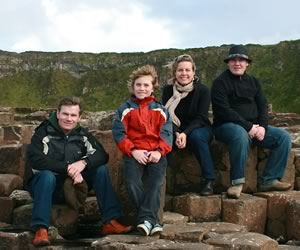
From Headwaters to Ulster
Apr 8, 2013 | | BlogsOff the beaten path, a quick list of some lesser-known must see, do, and stay tips.

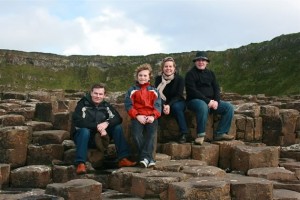
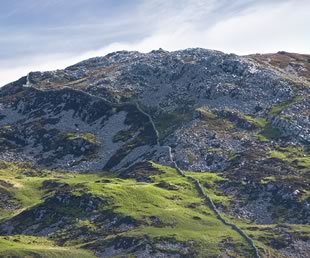
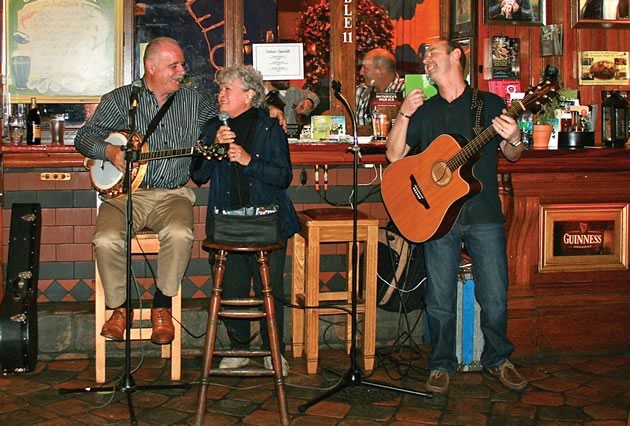






Lovely piece, very well written. Wish I had come across it years ago, or tears ago as some Irish would say. Staying near Palgrave for the summer, so must follow up on some of this. Spent 50 years in journalism, starting in Armagh.
John KERNAGHAN from Palgrave on Jul 5, 2022 at 7:39 pm |
Liz, stumbled upon this today and what a great story. I too must be Fermanagh bound some day in search of my Brampton / Peel roots in the names of Rutledge, Cheyne, Young…oh and maybe cross the pond to Craignish Scotland where my Caledon Campbells are from. Both golf courses (Brampton and Devil’s Paintbrush) are on original “family” lands…quite an interesting discovery!! Cheers, Dianne Prince George B.C.
Dianne Quinn from Prince George B.C. Can. on Jan 20, 2019 at 8:18 pm |
Great article ! I made the same trip several years ago with my parents. Some of my ancestors came from Co. Monaghan and other from Co. Cavan. They were Ulster Scots too.
Brian McConnell from Digby on Oct 11, 2016 at 5:00 am |
Your information on the ‘make work’ projects is either incomplete or interpreted incorrectly. The walls and other building projects did not ‘give a purpose to those who had lost the will to live’. They do not reflect ‘the primal need to maintain even a shred of dignity and self-determination.’ They reflect only the cruelty and prejudice of the government of the time. The Famine walls and roads were built by people forced to work despite hunger and illness because it was the policy of the government of the time that the Irish had to be taught not to expect a handout, not to be feckless and not to be lazy. The Famine was to be the occasion for a salutary lesson for the ‘primitive’ Irish. People were required to perform arduous physical labour before they got paid. They did not get paid in food. They were paid in money because emergency food supplies of ‘Indian meal’ that were imported by the government to feed the starving were not given away; people who had lived in a barter economy were forced to earn money in order to buy the emergency food supplies. I recommend you read ‘The Great Hunger’ by Cecil Woodham-Smith for an excellent treatment of government policy and its devastating effect.
Margaret on Oct 7, 2014 at 12:35 pm |
Thanks for the post. As the article states, the comment about giving “a purpose to those who had lost the will to live” was made by a local — actually, a historian with traceable roots dating back 400 years in that region and with ancestors who had survived the famine locally. Further, various sources that I checked, backed up the merit of his comment re possibly giving purpose/food for work.
That said, I agree (and he would too) that this brief passage is by no means a definitive representation of this horrific time in Irish history, nor of the realities of the famine across the country, which I understand varied a great deal. It was just a comment made by a reputed local expert about a specific situation. And of course, my interpretation about the human condition just fell from there. Thanks though for the reference, as I’m eager to learn more and you are clearly very well-read on this subject.
Liz Beatty from Caledon on Oct 8, 2014 at 4:46 am |